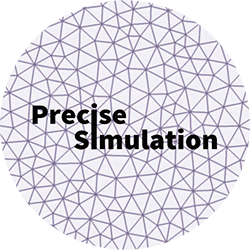
|
FEATool Multiphysics
v1.17.5
Finite Element Analysis Toolbox
|

|
FEATool Multiphysics
v1.17.5
Finite Element Analysis Toolbox
|
EX_AXISTRESSSTRAIN1 Example for hollow cylider axisymmetric stress-strain.
[ FEA, OUT ] = EX_AXISTRESSSTRAIN1( VARARGIN ) Example to calculate displacements and stresses in a hollow cylinder in axisymmetric/cylindrical coordinates.
Ref. 4.1.9 Long (generalized plane strain) cylinder subjected to internal and external pressure. [1] Applied Mechanics of Solids, Allan F. Bower, 2012 (http://solidmechanics.org/).
Accepts the following property/value pairs.
Input Value/{Default} Description
-----------------------------------------------------------------------------------
a scalar {1.5} Cylinder inner radius
b scalar {2} Cylinder outer radius
l scalar {3} Cylinder length
pa scalar {5e3} Inner load force
pb scalar {20e4} Outer load force
E scalar {200e9} Modulus of elasticity
nu scalar {0.3} Poissons ratio
igrid scalar 0/{1} Cell type (0=quadrilaterals, 1=triangles)
hmax scalar {0.1} Max grid cell size
sfun string {sflag2} Shape function for displacements
iplot scalar 0/{1} Plot solution (=1)
.
Output Value/(Size) Description
-----------------------------------------------------------------------------------
fea struct Problem definition struct
out struct Output struct
cOptDef = { 'a', 0.9;
'b', 2;
'l', 3;
'pa', 5e3;
'pb', 20e4;
'E', 200e9;
'nu', 0.3;
'igrid', 0;
'hmax', 0.01;
'sfun', 'sflag2';
'iplot', 1;
'tol', 5e-2;
'fid', 1 };
[got,opt] = parseopt(cOptDef,varargin{:});
fid = opt.fid;
% Geometry and grid.
a = opt.a;
b = opt.b;
l = opt.l;
fea.geom.objects = { gobj_rectangle( a, b, 0, l, 'R1' ) };
if ( opt.igrid==1 )
fea.grid = gridgen( fea, 'hmax', opt.hmax, 'fid', fid );
else
fea.grid = rectgrid( ceil((b-a)/opt.hmax), ceil(l/opt.hmax), [a b;0 l] );
if( opt.igrid<0 )
fea.grid = quad2tri( fea.grid );
end
end
n_bdr = max(fea.grid.b(3,:)); % Number of boundaries.
% Axisymmetric stress-strain equation definitions.
fea.sdim = { 'r', 'z' };
fea = addphys( fea, @axistressstrain );
fea.phys.css.eqn.coef{1,end} = { opt.nu };
fea.phys.css.eqn.coef{2,end} = { opt.E };
fea.phys.css.sfun = { opt.sfun opt.sfun }; % Set shape functions.
% Boundary conditions.
bctype = mat2cell( zeros(2,n_bdr), [1 1], ones(1,n_bdr) );
[bctype{2,:}] = deal( 1 );
fea.phys.css.bdr.coef{1,5} = bctype;
bccoef = mat2cell( zeros(2,n_bdr), [1 1], ones(1,n_bdr) );
bccoef{1,2} = opt.pb*b;
bccoef{1,4} = opt.pa*a;
fea.phys.css.bdr.coef{1,end} = bccoef;
% Solve.
fea = parsephys( fea );
fea = parseprob( fea );
fea.sol.u = solvestat( fea, 'icub', 1+str2num(strrep(opt.sfun,'sflag','')), 'fid', fid );
% Postprocessing.
n = 20;
r = linspace(a,b,n);
z = l/2*ones(1,n);
pa = opt.pa; pb = -opt.pb; E = opt.E; nu = opt.nu;
% 4.1.9 http://solidmechanics.org/Text/Chapter4_1/Chapter4_1.php#Sect4_1_9
u_ref = (1+nu)*a^2*b^2/E/(b^2-a^2)*( (pa-pb)./r' + (1-2*nu)*(pa*a^2 - pb*b^2)/a^2/b^2*r' );
sr_ref = (pa*a^2-pb*b^2)/(b^2-a^2) - a^2*b^2/(b^2-a^2)./(r').^2*(pa-pb);
st_ref = (pa*a^2-pb*b^2)/(b^2-a^2) + a^2*b^2/(b^2-a^2)./(r').^2*(pa-pb);
sz_ref = 2*nu*(pa*a^2-pb*b^2)/(b^2-a^2);
u = evalexpr( fea.phys.css.eqn.vars{3,2}, [r;z], fea );
w = evalexpr( fea.phys.css.eqn.vars{4,2}, [r;z], fea );
sr = evalexpr( fea.phys.css.eqn.vars{5,2}, [r;z], fea );
st = evalexpr( fea.phys.css.eqn.vars{6,2}, [r;z], fea );
sz = evalexpr( fea.phys.css.eqn.vars{7,2}, [r;z], fea );
if( opt.iplot>0 )
subplot(1,2,1)
postplot( fea, 'surfexpr', fea.phys.css.eqn.vars{3,2} )
title('r-displacement')
subplot(1,2,2), hold on
plot(u_ref,r,'r-')
plot(u,r,'b.')
legend('exact solution','computed solution')
xlabel('r')
grid on
end
% Error checking.
out.erru = norm( u_ref - u )/norm( u_ref );
out.errw = norm( w );
out.errsr = norm( sr_ref - sr )/norm( sr_ref );
out.errst = norm( st_ref - st )/norm( st_ref );
out.errsz = norm( sz_ref - sz )/norm( sz_ref );
out.err = [ out.erru, out.errw, out.errsr, out.errst, out.errsz ];
out.pass = all(out.err < opt.tol);
if( nargout==0 )
clear fea out
end